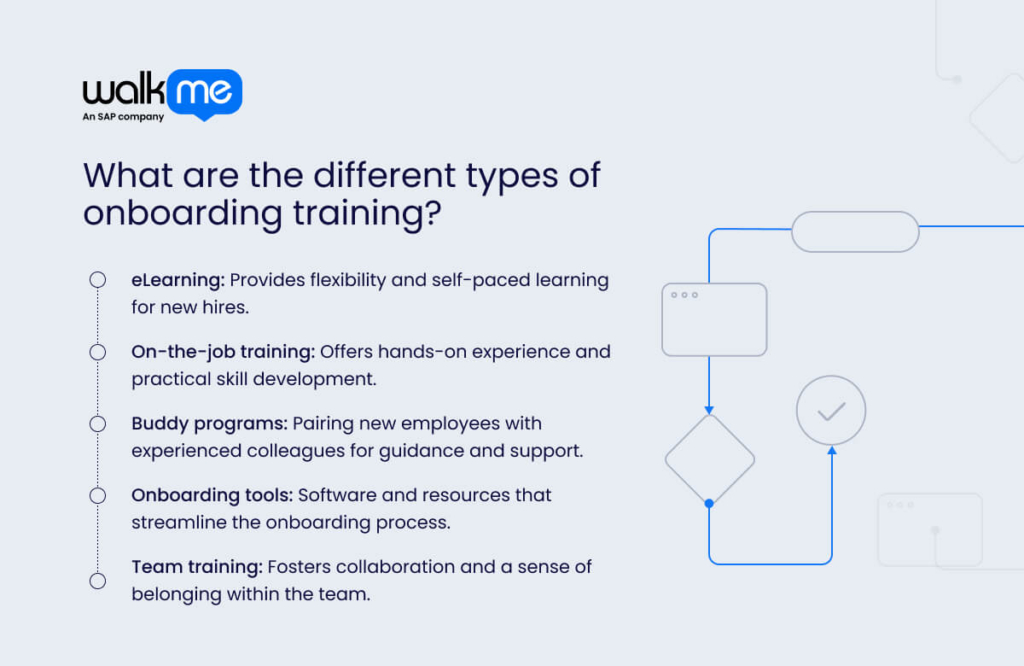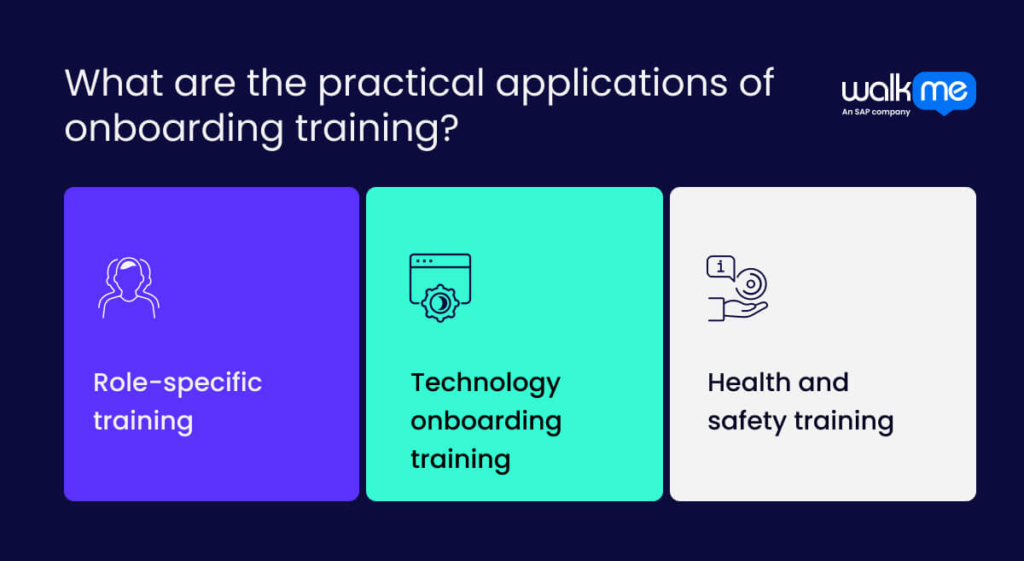Employee onboarding is a comprehensive process designed to help new employees integrate smoothly into an organization.
Onboarding training is a type of employee training that plays a key role in building commitment, boosting confidence, and enhancing the employee experience from day one.
This article will explore the training aspect of onboarding, focusing on how it drives employee development and engagement. It will define onboarding training, discuss effective employee training methods, and highlight the key goals achievable through a well-structured training plan.
By the end, you’ll understand how to combine relevant content with the right training techniques to ensure success during onboarding.
What is onboarding training?
Onboarding training refers to an organization’s activities and initiatives as part of the onboarding process.
These initiatives equip new employees with the knowledge, skills, and resources they need to integrate into their roles, understand company policies, and contribute effectively from day one.
Onboarding training may include:
- Introductions to company-specific approaches to tasks, processes, and workflows
- Briefings about company policies, hierarchies, and responsibilities
- Role-specific skills training, whether in technical skills, soft skills, or other practical needs
During onboarding, new employees will also participate in many tasks that do not count as training. Socializing, administration, and technology access are all essential but are not “training.”
The overall aim of onboarding is to create a sense of belonging, ensure cultural fit, and enhance employee experience. In combination with other activities, onboarding training plays a vital role in achieving these goals.
What are the different types of onboarding training?

In this section, we will introduce the most important types of onboarding training that can set new employees up for success. These include:
- eLearning: Provides flexibility and self-paced learning for new hires.
- On-the-job training: Offers hands-on experience and practical skill development.
- Buddy programs: Pairing new employees with experienced colleagues for guidance and support.
- Onboarding tools: Software and resources that streamline the onboarding process.
- Team training: Fosters collaboration and a sense of belonging within the team.
Each type plays a unique role, and when used together, they contribute to a seamless and effective onboarding experience.
eLearning
eLearning offers many opportunities for effective onboarding training. One of the great ways to do this is through self-paced online courses.
This method offers flexibility and accessibility, allowing employees to learn essential information about company policies, procedures, and culture at their own pace and schedule. The onboarding process could include modules covering company history, HR policies, safety protocols, and job-specific training accessible via a user-friendly online platform.
This method is suitable for organizations looking to streamline the onboarding process, especially those companies with remote onboarding needs.
On-the-job training
On-the-job training involves new hires learning their roles and responsibilities while performing tasks within the company environment. This method works exceptionally well for onboarding because it provides hands-on experience, allowing employees to grasp job requirements and expectations quickly.
Job shadowing, cross-training, and job rotation are all effective ways to train people while they are in their roles.
On-the-job training is suitable for various roles and industries, especially those that require practical skills and the real-time application of knowledge.
Buddy programs
An onboarding buddy program pairs new hires with experienced employees who serve as informal guides during the initial phase of employment. It is less formal than coaching, mentoring, or performance management.
This training approach can help new staff learn about the best and worst of company culture and expectations.
Buddy programs work well with the social aspects of onboarding. They support a sense of belonging and integration within the organization, helping new employees acclimate quickly and feel valued.
Onboarding tools
Onboarding tools are not a training method in the strictest sense, but they deserve a mention here. Onboarding software tools are useful for combining all the tasks required in onboarding training while keeping a clear record of employee progress through the system.
Employee onboarding tools are an excellent way to bring several features together, such as:
- Administration tasks and paperwork
- A company information hub
- Task management
- Customized training
Onboarding tools can link with other core business software, such as digital adoption platforms (DAPs) and corporate learning management systems (LMS)
Onboarding tools help to keep the multi-faceted onboarding tasks and responsibilities streamlined, convenient, and accessible.
Team training
Team training is part of the onboarding process in particular situations, such as:
- When a start-up is hiring a lot of new people at once
- When a larger business creates a new team
- When a remote or hybrid team meets together
Team training may focus on team-building activities that help employees develop mutual camaraderie, collaboration, and trust. It could also focus on developing skills that everyone on the team needs.
Learning as a team is especially important for industries in which employee knowledge and team collaboration always go together, such as healthcare, aviation, and engineering. However, many types of businesses can benefit from effective team training.
What are the practical applications of onboarding training?

Onboarding is often a practical process with clear, straightforward goals. However, as a classic Sloan Review article highlighted over a decade ago, it should not be a one-sided transaction where new employees are simply “indoctrinated” into the company’s vision.
Onboarding can become a powerful tool if you leverage the best methods for key interventions. It can boost capabilities, improve morale, and create a positive experience.
In this section, we’ll explore scenarios in which effective onboarding training significantly impacts employee experience, focusing on the areas where it makes the most difference. In particular, we will look at:
- Role-specific training
- Technology onboarding training
- Health and safety training
This trio is just a small selection of the many relevant applications of onboarding training. Nonetheless, it offers a clear overview of the scope of this activity.
Role-specific training
Role-specific onboarding is tailored to equip new employees with the knowledge, skills, and competencies required to excel in their job roles.
This training provides detailed insights into job responsibilities, workflows, procedures, and best practices relevant to their positions. Training new staff in this area is crucial for helping them understand their roles clearly, perform tasks efficiently and contribute effectively to organizational goals.
Domain-specific training may be procedural, but sometimes, the company must ensure that each new hire has a basic core of technical training.
How to implement it
Role-specific training is important at every level of a company. Think about the following ideas if you’re trying to improve your company’s offering:
- Understand the needs of your new staff as clearly as possible. If new employees arrive with significant job experience, they won’t need much more onboarding training.
- Job rotation and shadowing effectively familiarize new hires with leadership roles. However, these programs require time and effort, so they should be deployed only when necessary.
- Cross-training can be a great way to inspire new staff. Whether through informal instruction or formal mentoring programs, learning from experienced staff helps to build a secure and happy place in the company.
- Hands-on workshops and simulations can help employees focus on key tasks and scenarios specific to each role.
The best role-specific training will combine all these methods (and more).
Technology onboarding training
Technological onboarding training introduces new employees to the digital tools, software platforms, and technological systems used within the organization.
After staff confirm their access, they must quickly familiarize themselves with the technology they need to do their jobs. Technology is vital to everyone’s work in the modern digital workplace.
However, training new staff in software is not always easy. Challenges in technological onboarding training may arise from the complexity of software applications, varying levels of tech literacy among employees, and the need for continuous updates as new technologies emerge.
How to implement it
HR Leaders can easily forget about the challenges of technology onboarding. They should all make sure they think about the following points for new hires:
- If your tech stack is relatively simple, workshops and briefings may be enough to help new employees understand the basics. After all, most people learn most effectively when they apply their knowledge. A simple explanation could be enough to get them started before mastering their software on the job.
- Most companies have a much more complicated software ecosystem. Without effective intervention, new staff will endure the challenges of digital friction. DAPs have a proven track record of delivering great onboarding experiences in these cases.
- For more detailed technological work, other eLearning techniques will support the deepest levels of understanding.
Health and safety training
Health and safety training educates new employees about workplace hazards, safety protocols, emergency procedures, and regulatory compliance measures to prevent accidents and injuries.
Training new staff in this area is crucial to ensuring their well-being, promoting a safety-conscious culture, and reducing the risk of workplace incidents.
Some barriers to health and safety training may include complex regulations, language barriers, employees’ varying levels of prior knowledge, and the need for practical, hands-on training to reinforce theoretical concepts.
How to implement it
Effective onboarding for health and safety protocols must combine theoretical and practical elements. Consider the following ways to achieve this:
- eLearning is useful for covering a range of health and safety issues, including workplace hazards, emergency procedures, and safety regulations. Interactive quizzes, simulations, and videos enhance learning retention and engagement.
- On-site workshops are essential for technical jobs. They offer hands-on training in safety protocols led by experienced trainers. The workshops cover using safety equipment, identifying hazards, and practicing emergency responses.
- Practical exercises allow employees to practice safety procedures in real scenarios, improving their understanding and response to potential hazards.
- Hands-on training provides employees with direct experience in applying safety protocols, ensuring they can handle workplace safety challenges.
Onboarding training for great performance
When planning a new onboarding process, remember that it goes beyond paperwork or casual social events with the team.
While these are valuable elements, effective onboarding training is crucial to ensure new hires make meaningful contributions to the company.
This process should be engaging, respectful, and sensitive to the needs of the new employees, helping them integrate smoothly.
Considering the significant costs associated with advertising, interviewing, recruiting, and hiring new staff, implementing a well-structured onboarding program can help ensure your new employees are equipped and motivated to do their best work.
FAQs
The five Cs of onboarding are Compliance, Clarification, Culture, Connection, and Contribution. These elements ensure that new hires understand company policies, roles, values, and goals while establishing relationships and feeling valued in their new positions. This ultimately leads to better engagement and productivity.
The 4-step onboarding process includes:
- Preparation before the first day (documents, workspace setup)
- Orientation (introducing company culture and policies)
- Training (role-specific skills and tools)
- Integration (ongoing support, feedback, and development to ensure successful adaptation)
Onboard training refers to providing new employees with the necessary knowledge, skills, and resources to integrate into their roles effectively. It helps employees understand their responsibilities, company culture, policies, and procedures, preparing them for success in their new position from day one.
Yes, employees are typically paid for onboarding training, which is considered part of their employment. As such, it is a work-related activity, and employees are compensated for the time spent attending training sessions, completing modules, or engaging in any required activities.

